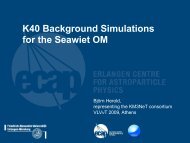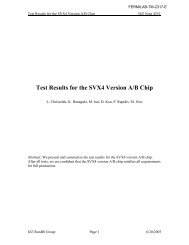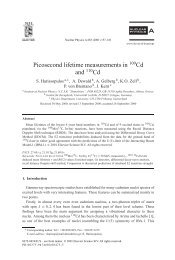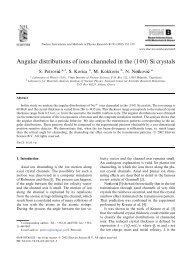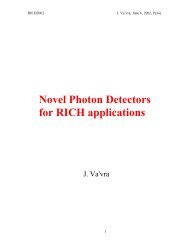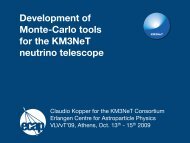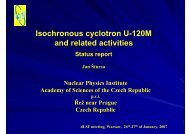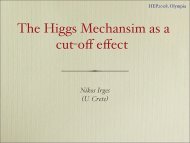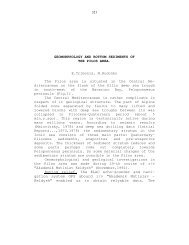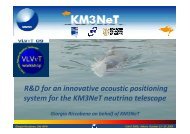"Operation and performance of the NESTOR test detector" Nucl.Instr ...
"Operation and performance of the NESTOR test detector" Nucl.Instr ...
"Operation and performance of the NESTOR test detector" Nucl.Instr ...
Create successful ePaper yourself
Turn your PDF publications into a flip-book with our unique Google optimized e-Paper software.
ARTICLE IN PRESS<br />
G. Aggouras et al. / <strong>Nucl</strong>ear <strong>Instr</strong>uments <strong>and</strong> Methods in Physics Research A 552 (2005) 420–439 437<br />
(in a circle <strong>of</strong> 100 m 11 radius at 100 m above <strong>the</strong><br />
detector). The total efficiency, corresponding 12 to<br />
a Monte Carlo production model following <strong>the</strong><br />
angular distribution <strong>of</strong> Eq. (1), with a ¼ 4:5, was<br />
found to be: ¼ 3:89 10 4 0:04 10 4 .<br />
The vertical atmospheric muon intensity, found<br />
using formula (2) gives:<br />
I 0 ¼ 8:8 10 9 1:3 10 9 cm 2 s 1 sr 1 (3)<br />
where <strong>the</strong> estimated error is calculated from<br />
statistical uncertainties in <strong>the</strong> data <strong>and</strong> Monte<br />
Carlo simulation <strong>and</strong> <strong>the</strong> measurement error on<br />
<strong>the</strong> index a. The cited uncertainty comes from all<br />
<strong>the</strong> contributions <strong>of</strong> <strong>the</strong> uncertainties <strong>of</strong> <strong>the</strong><br />
quantities in <strong>the</strong> right-h<strong>and</strong> side <strong>of</strong> Eq. (2), added<br />
in quadrature. The dominant uncertainty however<br />
is <strong>the</strong> error <strong>of</strong> <strong>the</strong> spectral index a. The reconstruction<br />
efficiency (e) depends on <strong>the</strong> zenith angle, so it<br />
also depends on <strong>the</strong> spectral index a. In this way<br />
<strong>the</strong> uncertainty <strong>of</strong> <strong>the</strong> reconstruction efficiency has<br />
two contributions: <strong>the</strong> one is <strong>the</strong> statistical<br />
uncertainty that has been estimated from <strong>the</strong><br />
calculation <strong>of</strong> <strong>the</strong> reconstruction efficiency via<br />
<strong>the</strong> Monte Carlo <strong>and</strong> <strong>the</strong> second is through <strong>the</strong><br />
propagation from <strong>the</strong> spectral index a. The latter<br />
contribution to <strong>the</strong> estimation uncertainty <strong>of</strong> <strong>the</strong><br />
vertical flux is insignificant (less than 0.15 10 9 );<br />
details could be found in Ref. [30].<br />
This measured intensity is in good agreement<br />
with predictions <strong>of</strong> <strong>the</strong> vertical intensity <strong>of</strong> <strong>the</strong><br />
atmospheric muons at a depth <strong>of</strong> 3800 m.w.e, by<br />
Okada [27] (I 0 ¼ 8:8 10 9 cm 2 s 1 sr 1 ) <strong>and</strong><br />
Bugaev et al. [33,34] (I 0 ¼ 9:0 10 9 cm 2 s 1 sr 1 )<br />
as well as with <strong>the</strong> previous <strong>NESTOR</strong> measurements<br />
[35] <strong>of</strong> I 0 ¼ 9:8 10 9 4:0 10 9 cm 2 s 1 sr 1<br />
at depths between 3700 <strong>and</strong> 3900 m. It is also<br />
consistent with <strong>the</strong> DUMAND measurement [32]<br />
<strong>of</strong> I 0 ¼ 1:31 10 8 0:4 10 8 cm 2 s 1 sr 1 at a<br />
depth <strong>of</strong> 3707 m.<br />
A more accurate analysis <strong>of</strong> <strong>the</strong> data with a<br />
simultaneous estimation <strong>of</strong> <strong>the</strong> index a <strong>and</strong> <strong>the</strong><br />
11 Approximately twice <strong>the</strong> light transmission length in <strong>the</strong><br />
water at <strong>the</strong> experimental site.<br />
12 The re-weighting <strong>of</strong> <strong>the</strong> Monte Carlo events, produced with<br />
<strong>the</strong> Okada model, to follow <strong>the</strong> differential flux <strong>of</strong> Eq. (1), is<br />
described in Ref. [30].<br />
vertical muon intensity I 0<br />
publication. [30].<br />
8. Conclusions<br />
could be found in<br />
In March 2003, <strong>the</strong> <strong>NESTOR</strong> collaboration<br />
successfully deployed a <strong>test</strong> floor <strong>of</strong> <strong>the</strong> detector<br />
tower, fully equipped with final electronics <strong>and</strong><br />
associated environmental sensors to a depth <strong>of</strong><br />
3800 m, situated 80 m above <strong>the</strong> sea bottom<br />
station.<br />
The deployed detector was continuously operated<br />
for more than a month. The monitored<br />
experimental parameters, operational <strong>and</strong> environmental,<br />
remained stable within <strong>the</strong> accepted<br />
tolerances whilst <strong>the</strong> readout <strong>and</strong> DAQ chain<br />
performed well <strong>and</strong> with practically zero deadtime.<br />
The 1.1% <strong>of</strong> <strong>the</strong> total experimental time was lost<br />
due to bioluminescent activity around <strong>the</strong> detector.<br />
This 1% dead time is consistent with previous<br />
measurements in <strong>the</strong> same site done with autonomous<br />
drops [19]. Events collected during such<br />
periods <strong>of</strong> activity were easily identified <strong>and</strong><br />
rejected.<br />
Several studies have been made to ensure that<br />
<strong>the</strong> event selection trigger was unbiased <strong>and</strong> that<br />
<strong>the</strong> collected light on <strong>the</strong> pmts can be attributed to<br />
<strong>the</strong> expected natural sources. The pmt pulse height<br />
distributions, <strong>the</strong> trigger rates <strong>and</strong> <strong>the</strong> total<br />
number <strong>of</strong> photoelectrons inside <strong>the</strong> trigger<br />
window as functions <strong>of</strong> <strong>the</strong> signal thresholds <strong>and</strong><br />
coincidence level settings as well as <strong>the</strong> arrival time<br />
distribution <strong>of</strong> <strong>the</strong> accumulated photoelectrons,<br />
agree very well with Monte Carlo predictions<br />
based on <strong>the</strong> atmospheric muon flux parameterization<br />
<strong>of</strong> Okada [27], on <strong>the</strong> natural K 40 radioactivity<br />
in <strong>the</strong> sea water <strong>and</strong> <strong>the</strong> pmt dark currents<br />
<strong>and</strong> after pulses.<br />
In parallel, calibration in <strong>the</strong> sea using <strong>the</strong> LED<br />
flasher units mounted above <strong>and</strong> below <strong>the</strong><br />
detector floor, provided a rigorous <strong>test</strong> on <strong>the</strong><br />
time stability <strong>of</strong> <strong>the</strong> detector as well as a<br />
measurement <strong>of</strong> <strong>the</strong> resolution <strong>of</strong> <strong>the</strong> arrival time<br />
<strong>of</strong> <strong>the</strong> pmt signals.<br />
A subset <strong>of</strong> <strong>the</strong> accumulated data, consisting <strong>of</strong><br />
events with six or more pmt pulses inside a 60 ns



